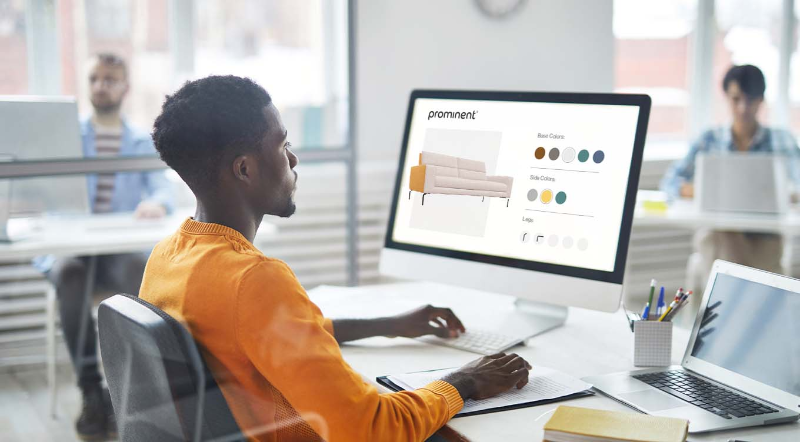There was once a time when the only option you had when it came to actually testing a prototype, was to have physical samples. Thanks to digital tools though, businesses can now opt for 3D visual product prototyping instead. But is this route better than physical samples? We’ll run through the basics, pros, and cons of visual prototyping to give you the info you need to decide the best path for your business.
What is Visual Product Prototyping?
When you’re pitching a product or testing the functionality of an item, a prototype is needed. Physical samples were the go-to in the past. Software programming has delivered another option though for prototyping: 3D visual products.
A visual product prototype is a rendering of a model or sample, usually used in product development. Once a model is developed, it can be tested for errors and functionality. When a design is settled, the company can then choose to use a visual representation of the product rather than a physical sample to pitch to investors or sell to their clients.
Examples of Visual Prototypes
Visual prototypes aren’t exactly a new thing. However, tech developments over the years have definitely delivered new routes for product development teams to experiment and evolve.
– Drawings and Similar Renderings
Drawings were a common option in the past (and still are) if you wanted to show how an item looked and describe its functions, but they can’t actually be used to test an item.
It’s known that it would only show the item in a 2D model, which would require the company to explain more of the design in their presentation. However, they are a valuable resource during the early stages of planning; not so much for a pitch.
– Physical Prototypes
This may seem a bit of a conundrum – we’re talking about types of visual prototypes, not physical. Yet there are physical prototypes that fall under this category now thanks to 3D printing.
3D printing and similar methods have helped companies build a prototype for a fraction of the cost. Though this route may not help with functionality as much as you’d like and it won’t show off the final materials in the cost, it can help display the final design of a product. Beware though, it’s not a good option for testing, as it probably isn’t using the same materials your product will use.
– 3D Models
Software has made crafting a 3D model of a prototype easier than ever. It gives users a look at a product from all angles, but there are some tools out there that can also let you test the product in a variety of situations, even though you don’t have a physical sample in front of you. This allows you to test for errors and ensure proper functionality before you even send it to a manufacturer.
Pros and Cons of 3D Prototypes
There are a number of factors that play a role in choosing the best prototyping for you, your product, and your business. Hopefully, these pros and cons will help out in your decision-making process when it comes to samples and visual product prototyping.
Pro: It’s Less Expensive
There’s no doubt: visual prototyping is less expensive than physical samples. You’re not using the materials to build a product, so you’re saving money there. Visual samples allow you to change design time and time again – if you did this with a physical product, you’d have to pay for an entirely new prototype each time.
3D models also let you test more without broken or wasted physical products. You can catch and correct errors before it’s ever made into a physical item. The right software should let you test your prototype in simulated real-life conditions, ensuring you can test for just about any situation your finished product would be in.
Pro: They Perform Just as Well as Physical Samples
Although you may not think so, visual prototypes work just as well as physical samples, especially when it comes to company predictions. If you have two routes for your design, for example, visual prototypes can help you find the best one.
Research by Seenu Srinivasan, a Stanford Business School Professor of Marketing and Management Science, found that “the virtual prototype worked as well as the physical prototypes when predicting which design would be more successful.”
This is also true for presentations. Visual prototypes can allow your investors or clients to thoroughly inspect an item. Product development teams no longer have to order several prototypes to ship off to potential clients. One visual representation can be created and shared with everyone, so even remote meetings can be successful and have everyone on the same page, which is particularly relevant considering the current situation.
Con: It’s Not The Right Route for Every Product
Visual product prototyping has its benefits, but it’s also not the best route for every product under the sun. It’s quite possible that, although the software can test a prototype in simulated real-life conditions, it doesn’t test in every situation needed, for example. Product development teams need to weigh the options themselves to ensure they’re choosing the best route for their prototype.
All things considered…
No matter your industry, if you sell products and develop new pieces, you need prototypes. Visual product prototyping options, like 3D models, help your business to save time, money, effort, and headaches by streamlining the entire process.
Are you interested in visual product prototyping of your product and design? It’s easy to get started with Expivi. Uncover what we do and how we can assist you with product design and development.
